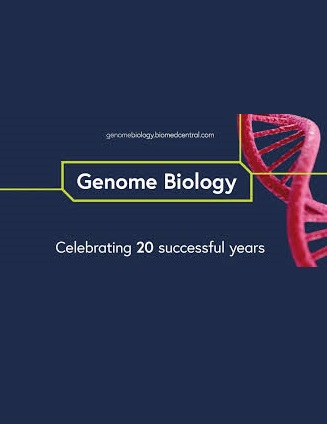蜂后工蜂等级决定中与极端表型可塑性相关的基因组内冲突
IF 10.1
1区 生物学
Q1 BIOTECHNOLOGY & APPLIED MICROBIOLOGY
引用次数: 0
摘要
蜜蜂(Apis mellifera)的种姓决定是发育可塑性的例证,其中幼虫饮食的差异导致相同的基因型产生长寿,繁殖的蜂王或短暂,兼性不育的工蜂。除了环境因素外,从母亲(母系)遗传的基因与父亲(父系)遗传的基因之间的基因组内冲突被认为会影响潜在的性状。在蜜蜂中,基因组内冲突的亲缘关系理论预测,父系的选择倾向于增强个体适应性的特征,比如加速生长或增加体型——这些特征在蜂王的幼虫中更活跃。虽然原生亲本效应在蜜蜂中有报道,但相关的基因调控机制尚不清楚。虽然DNA甲基化是真核动物、被子植物和一些昆虫中亲本偏倚转录的基础,但在蜜蜂或其他群居昆虫中却没有作用。对受精后192 h的蜂王和工蜂幼虫的等位基因特异性转录组分析揭示了数百个具有亲本效应的基因,与工蜂幼虫相比,蜂王幼虫表现出过多的父本偏倚转录。在基因组聚类、重组率、内含子长度和CpG密度等方面,具有亲本偏倚转录的基因与其他分类群中的印迹基因相似,其中一个子集在24个hpf卵中显示亲本偏倚转录。等位基因特异性ChIP-seq分析表明,父母来源对H3K27me3、H3K4me3和H3K27ac的种姓特异性谱的影响与父母来源的转录有关。这些发现表明,亲本起源的基因组内冲突可能会影响表型可塑性,并可能与组蛋白翻译后修饰有关,这表明社会性昆虫存在“非规范”基因组印记样系统。本文章由计算机程序翻译,如有差异,请以英文原文为准。
Intragenomic conflict associated with extreme phenotypic plasticity in queen-worker caste determination in honey bees (Apis mellifera)
Caste determination of honey bees (Apis mellifera) exemplifies developmental plasticity, where differences in larval diet result in identical genotypes yielding either long-lived, reproductive queens or short-lived, facultatively sterile workers. Beyond environmental factors, intragenomic conflict between genes inherited from the mother (matrigenes) versus the father (patrigenes) is hypothesized to influence the underlying traits. In honey bees, the Kinship Theory of Intragenomic Conflict predicts selection on patrigenes to favor traits enhancing individual fitness, such as accelerated growth or increased body size—traits more active in queen-destined larvae. Although parent-of-origin effects have been reported in honey bees, the associated gene regulatory mechanisms remain unknown. While DNA methylation underlies parent-biased transcription in eutherians, angiosperms, and some insects, it is not operating in honey bees or other social insects. Allele-specific transcriptome analyses on queen- and worker-destined larvae at 192 h post-fertilization (hpf) reveal hundreds of genes with parent-of-origin effects, with queen-destined larvae showing overrepresentation of patrigene-biased transcription relative to worker-destined larvae. Genes with parent-biased transcription resemble imprinted genes in other taxa regarding genomic clustering, recombination rate, intron length, and CpG density, with a subset showing parent-biased transcription in 24 hpf eggs. Allele-specific ChIP-seq analyses demonstrate that parent-of-origin effects on caste-specific profiles of H3K27me3, H3K4me3, and H3K27ac are associated with parent-of-origin transcription. These findings suggest that parent-of-origin intragenomic conflict may influence phenotypic plasticity and may be associated with histone post-translational modifications, suggesting a “noncanonical” genomic imprinting-like system in social insects.
求助全文
通过发布文献求助,成功后即可免费获取论文全文。
去求助
来源期刊

Genome Biology
Biochemistry, Genetics and Molecular Biology-Genetics
CiteScore
21.00
自引率
3.30%
发文量
241
审稿时长
2 months
期刊介绍:
Genome Biology stands as a premier platform for exceptional research across all domains of biology and biomedicine, explored through a genomic and post-genomic lens.
With an impressive impact factor of 12.3 (2022),* the journal secures its position as the 3rd-ranked research journal in the Genetics and Heredity category and the 2nd-ranked research journal in the Biotechnology and Applied Microbiology category by Thomson Reuters. Notably, Genome Biology holds the distinction of being the highest-ranked open-access journal in this category.
Our dedicated team of highly trained in-house Editors collaborates closely with our esteemed Editorial Board of international experts, ensuring the journal remains on the forefront of scientific advances and community standards. Regular engagement with researchers at conferences and institute visits underscores our commitment to staying abreast of the latest developments in the field.
 求助内容:
求助内容: 应助结果提醒方式:
应助结果提醒方式:


